Artist Warning: this analysis of The Disciple contains spoilers. Artist
The protagonist of The Disciple, Sharad Nerulkar, above all is a seeker, and is deeply in love with music, aspiring for absolute union with his art; thus making this a love story, albeit, not a conventional one. The conflict in its external form is society and survival, and in its internal form is the inherent talent of the protagonist. The film belongs to the realist mode of filmmaking, and the authentic real settings and non-actors as characters in the film go a long way to achieve that goal. The protagonist is portrayed by Aditya Modak a real-life musician himself, who transforms effortlessly in the film from the age of 24 to 46, meeting the physical and internal challenges of the character quite effectively.
The film begins with the protagonist seated on the stage completely in love and reverence of, and in the shadow of, his guru rendering raag Jaunpuri at a Hindustani Classical Music concert. The filmmakers are not shy of the fact that Indian classical music is the universe of the film as there are various occasions besides this for multiple musical concert recitals. They believe that the audience who will want to experience the film authentically would also like to experience first-hand the flavour of a musical live performance. As a viewer, I was keenly aware that film is an artform and music is an independent artform. Since the film’s subject tackles Indian classical music, I was sensitive to the interplay or conversation between the two artforms as a total experience. Probing further on this interplay, I spoke to Aneesh Pradhan, the Music Director.
Although Hindustani Classical Music is nonrepresentational in that the musical elaboration does not represent specific events and situations, in the context of the film, music performances form an integral part of the narrative and Chaitanya Tamhane’s directorial vision has revealed many stories while taking the audience on a musical journey through these performances. The highly nuanced and subtle treatment of the film mirrors similar treatment experienced in khayal. Typically, a Hindustani Classical Music vocal concert can last for as long as three hours and more, but we had to restrict the duration in keeping with the requirements of the film. I took inspiration from the 78 rpm records that were published in the early part of the 20th century and that have some of the most brilliantly tailored 3–4-minute performances. (Aneesh Pradhan)
Questioned on whether the structure of Indian classical music played any role in that of The Disciple, Tamhane’s views brought an interesting dimension to the forefront.
I would say yes and no. When I wrote the script, I wrote it like I would write any other screenplay. But they say that a film is written thrice — first, during the scripting stage, the second, when you shoot it, and then during the editing. (The same, incidentally, is true when you are doing the sound for a film.) In both, the production and the postproduction stages, the rhythm of the film and individual scenes became very important to me. This would be the case even if I am directing a film that has nothing to do with music.
By virtue of the fact that they were performing music, I decided that the tanpura would be the bed of sound that is guiding the scene or guiding the rhythm of the scene. I had to do justice and be respectful to the structure of Indian classical music, or rather, to the structure, to the mode, and to the rhythm of Indian classical music. And all that seeped into the final mix, the sound design, the edit, the rhythm of the scene, the length of the scene, and the transitions of the scene. It would be pretentious of me to say that I deliberately structured the film on the structure of Indian classical music. But to some extent, yes, the rhythm and structure of the film is definitely inspired and influenced by the music in the film and by the choices we have made in sound design. It’s a two-way process of the music influencing the film and the film influencing the music. (Chaitanya Tamhane)
Thus, I feel that the film with its subject and treatment is also an interesting opportunity for the audience to view in context of Indian classical aesthetics. The aim of the classical Indian artist with a work of art is to evoke a particular rasa (heightened emotional state) and make the audience experience something beyond mundane raw emotions. If I look at the film in this context of the exploration of a central emotion from the 8 basic rasas — Sorrow, Fear, Laughter, Anger, Wonder, Disgust, Love, Heroism — then personally Karuna (Sorrow) is the feeling that I am left with after experiencing the film. It feels like a melancholic mood that is all pervasive in the film; however, it is not one of dejection or hopelessness but rather of struggle and yearning. In fact, Indian art aesthetics exploring the psychological state of Sorrow includes the journey of other transient feelings and shades that make up a complex layered experience of that emotion. It may be interesting too to point out that the highest form of Sorrow in the Natyashastra (ancient Indian treatise on drama/art) is Compassion.
Technically speaking, in Indian classical music, the choices made in relation to the choice of notes and the arrangement of notes and rhythm create a mood in a raag. In the case of The Disciple, though, there is no overall raag scheme set in a particular mood exploration, as I was informed by the filmmaker and his team. I feel that the vilambit (the overriding slow rhythm) went a long way in helping the film explore a particular psychological state. However, this is my personal take on the film and its mood in context with ancient Indian aesthetics and a particular conscious emotional state. Tamhane’s view differs radically.
It wasn’t any one particular psychological state that I was trying to explore, if anything. I had wanted to show the transition or change in the psychological /emotional state of the character, which starts with a whirlpool of possibilities until slowly that dream starts fading away, that colour starts fading away, and maybe in some ways, he becomes more insecure. And that reflects in the music as well. Then he reaches a certain phase where he is trying to reach some kind of transcendence. And then there is a certain calm state of mind that he reaches in the end. At the level of the story, the film is about an artist struggling to find his inner voice, pursuing excellence, and negotiating his artistic expression in a fast-changing city like Mumbai. (Chaitanya Tamhane)
So, the film is about a hero on a quest and the goal set out for him appears to the forefront when we hear the wise words and advise from the recordings of Mai, his father’s guru, evocatively voiced by late Sumitra Bhave.
Saints and ascetics have attained this music after thousands of years of rigorous spiritual pursuit. It cannot be learnt so easily. Even ten lifetimes are not enough. The sacred texts don’t merely prescribe, “This raag uses the Pancham or that raag skips the Dhaivat.” Through this music, we are shown the path to the divine. There is a reason why Indian classical music is considered an eternal quest. And to embark on that quest you will have to surrender and sacrifice. If you want to earn money, raise a family, then perform love songs, or film songs. Don’t tread this path. If you want to tread this path, learn to be lonely and hungry.
These recurring passages in the film reenforce the kind of high standards that the goal embodies for our protagonist and brings to light the true spiritual nature of Indian classical music, making the other scenes and their treatment like a parallel universe of the real mundane world where the protagonist is failing and struggling to meet his goal, faced with the human conflict between his need for survival and his passion for experiencing the divine.
I would like to go on a slight tangent here. What makes these scenes with the spiritual guru come to life is the drowning hypnotic music that suspends reality, created by the tanpura. The filmmaker and his team have made a brilliant choice with this as the key instrument in the film instead of, say, a sitar or a flute. This is an Indian drone instrument that is usually played in the background and sustains the melody in a performance by providing a sustained harmonic drone; in The Disciple, though, the tanpura takes centerstage. The presence of the drone also embodies the concept of om, the elemental and eternal sound from which all other sounds flow.
The tanpuras that you hear constantly when Sharad is on his bike were tuned or detuned consciously to represent the mood of the protagonist or to add a dimension to the brooding, oppressive, or introspective tenor that was being experienced on screen. (Aneesh Pradhan)
The visual treatment by cinematographer Michal Sobocinski adds another dimension of poetic grace with its slow speed and gentle movements that further suspends us in this bubble that appears to be floating towards or away from the protagonist. It is interesting to observe that the background and space of this unfolding are the streets of Mumbai — the city as a character in the film literally juxtaposed to all that Mai speaks about as ideal demonstrates the corrupting influence of modernism.
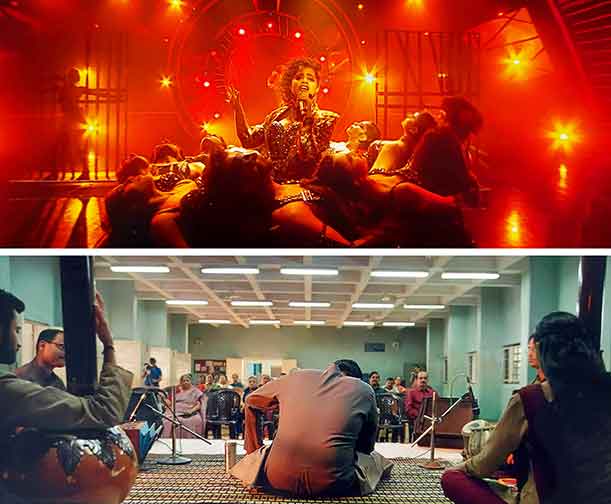 Further exploring the story, the climax of the film evocatively embodies one of the significant overarching themes of the film — the struggle between the ancient and modern. I would like to discuss the sequence of scenes that lead to the resolution of the film, starting with a film song and ending with a folk song, but including a raag at its central core.
Further exploring the story, the climax of the film evocatively embodies one of the significant overarching themes of the film — the struggle between the ancient and modern. I would like to discuss the sequence of scenes that lead to the resolution of the film, starting with a film song and ending with a folk song, but including a raag at its central core.
Starting from about 15 minutes towards the closing of the film, we are presented with the song of a reality show that represents the corrupting influence of modernism and commercialism — a humble participant at a talent show who had auditioned with a classical Indian music piece is later reduced to a dark seductress vamp; through this sequence, perhaps, the filmmakers are demonstrating how the sacredness of the classical form is eventually being replaced with cheap entertainment.
This above scene is followed by one in which the protagonist as a member of the audience witnesses a performance. And with the soundtrack of a J cut (that is, the audio of the next cut appears before the visual), we are soon drowned in the sonic womb of the tanpura. This then visually transitions to the last concert performance by the protagonist in which Tamhane and Pradhan have deliberately chosen to use a particular raag, Mia ki Malhar.
We did not follow any rasa or mood when it came to the selection of repertoire. But Sharad’s last concert scene is very poignant as he tries to find his voice or musical identity in the presence of an audience. For this scene, we tried unconventional melodic phrasing while using Mia ki Malhar, a raag prescribed for the monsoon. (Aneesh Pradhan)
Complimenting the soundtrack is the evocative camerawork (Polish cinematographer Michal Sobocinski) and actor staging, which begins with the camera capturing the protagonist from behind — the staging itself speaks volumes — before gently gliding through the air and coming bang frontal.
We did not want the film to be composed of only static shots, yet concepts like having the camera moving with the music seemed too music video-ish. Ultimately, we chose to sync the camera with Sharad’s emotional state — the way he thinks and perceives the world. I took inspiration from the likes of Tarkovsky’s Stalker (1979; cinematographed by Alexander Knyazhinsky) where the camera movement is unobtrusive and creates a sensation that something is going on that we are yet to understand. (Michal Sobocinski)[1]
Throughout the scene the audience experiences the inner conflict of the protagonist, and is held captive by the probing camera and the nature of the raag, which has a strong sense of seeking and pathos. The effective use of an evocative classical rendering in a film reminds me of Bade Ghulam Ali Khan’s rendering in the iconic lovemaking scene with the song ‘Prem jogan ban ke’ in Mughal-e-azam (1960). Except that, in The Disciple, the protagonist is trying to reach his beloved in vain. Midway through the raag the protagonist loses himself and walks out of the hall, and we are left with murmurs from the audience. That sudden walk out and interruption in the raag helps the audience of the film feel the chaos within the protagonist and effectively conveys his inner state of being.
The scene then cuts to black and silence. A long while later, we hear the reassuring rhythm of a train and the sweet giggles of a child; sounds that appear to emerge from the dak night of the soul. The image that fades in from black shows us that the protagonist has made his choice — he has accepted his mediocrity as an artist and stepped down from the high goal that he had set out for, encouraged by Mai. He has instead accepted the mundane bliss of married life. We are then led to a scene of a small gathering and stage quite like a concert hall but a bit smaller. This time, though, the occasion is the protagonist’s book launch, rather than his music concert. We enter this scene with the audience clapping on the soundtrack. This helps to subconsciously make the audience feel a sense of victory and acceptance for the protagonist.
Immediately following this, however, we have the last scene in which the film concludes with our protagonist back in the train, this time with his family sitting opposite him and him witnessing a singing folk street singer begging for alms. If I were to analyze the visual dimension of the scene and compare it with the first shot and scene of the film, it strikes me that now the protagonist does not have the symbolic object of his beloved (music), which was the tanpura, but is empty handed and instead observing a street player who now has the musical instrument. So, for me it is a story of lost love, there is still a longing for the beloved but the reality of life stares at him and he is coming to terms with it. The protagonist has not achieved the goal he set out to achieve as a traditional performing artist, but inspired by the lofty ideals of his guru, Mai, he stands at a distance and admires the beloved (music) knowing that he will never be one with her. So, there is a longing and pain but not a defeat. And instead of self-destruction there is acceptance.
 The film ends on a poetic note. Decoding the lyrics of the folk song sung by the musician in the train might yet again open another dimension to the theme of the film.
The film ends on a poetic note. Decoding the lyrics of the folk song sung by the musician in the train might yet again open another dimension to the theme of the film.
Oh, Seeker! Artist
At the edge of a well, oh seeker I sowed a tamarind seed
At the edge of a well, oh seeker I sowed a tamarind seed
The tree sprouts fish Artist
And casts a fine shade Artist
At the edge of a well, oh seeker
At the edge of a well, oh seeker
A deer was wed Artist
At the edge of a well, oh seeker, oh seeker
She gave birth to five fawns Artist
At the edge of a well, oh seeker Artist
The beauty of the film I feel lies in the fact that it juxtaposes the old and the new and in that it questions their values and principles and asks the audience to introspect. I think it helps discuss many dimensions of the ancient and modern. For one it helps put a spotlight on how art is taught and received. And it’s nice to spare a thought to the film’s title — The Disciple. The film revolves around five generations of the guru shishya parampara (student-teacher tradition) shown in the four relationships — one being the protagonist and his students, second being the protagonist and his guru, third being the protagonist and his father (revealed in flashback and showing the unsuccessful attempts of his father at attaining excellence), and the fourth being the father and his guru Mai, who in turn is also the protagonist’s guru as he listens to her recorded speeches and is inspired by them (Mai is presented as a powerful force in the film and is the most enlightened).
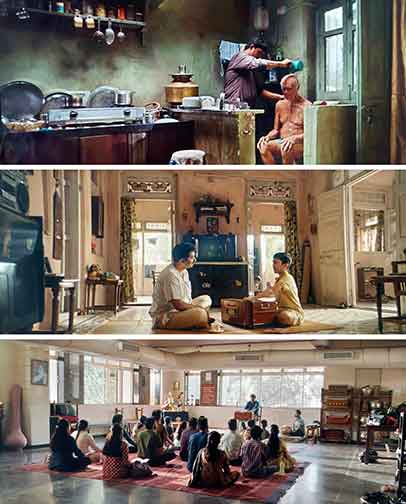 The Disciple introduces us for the most part to the practice in Indian classical music of the guru being not just a teacher for a few hours providing a service in exchange for money but as an imparter of knowledge gained through personal experience and handed down from one generation to the next (This comes to a full stop with the protagonist, who is instead a teacher in a music-school setup). The student in turn looks up to the guru as a father figure and feels obliged to care and look after him. Of course, this kind of dependence traditionally could lead to the guru taking undue advantage of the student and could lead to exploitation. However, the main narrative of the film deals with the relationship of the protagonist and his guruji, played brilliantly by Arun Dravid, a respected classical Indian musician himself, and the film draws a delicate balance in this equation. The guru in this case is not exploitative but vulnerable and old, and there is a bond of genuine concern and respect. Personally, for me, the film besides mirroring the journey of an artist could also be an opportunity for the audience to examine a dying tradition of the guru shishya parampara and question the new environment and approach to teaching in contemporary India.
The Disciple introduces us for the most part to the practice in Indian classical music of the guru being not just a teacher for a few hours providing a service in exchange for money but as an imparter of knowledge gained through personal experience and handed down from one generation to the next (This comes to a full stop with the protagonist, who is instead a teacher in a music-school setup). The student in turn looks up to the guru as a father figure and feels obliged to care and look after him. Of course, this kind of dependence traditionally could lead to the guru taking undue advantage of the student and could lead to exploitation. However, the main narrative of the film deals with the relationship of the protagonist and his guruji, played brilliantly by Arun Dravid, a respected classical Indian musician himself, and the film draws a delicate balance in this equation. The guru in this case is not exploitative but vulnerable and old, and there is a bond of genuine concern and respect. Personally, for me, the film besides mirroring the journey of an artist could also be an opportunity for the audience to examine a dying tradition of the guru shishya parampara and question the new environment and approach to teaching in contemporary India.
That such a film was made free from the constraints of commerce and entertainment goes a long way in favour of art and the artist (Tamhane). Kudos too to the Producer (Vivek Gomber) and Executive Producer (Alfonso Cuaron) for being a rock support to such sincere subjects. The subject, its treatment and it coming to life is inspiring for artists like me to continue treading on the path and discovering for ourselves the delicate balance between our material self and the higher self, and completing our own unique love story.
[1]Kuzma, Darek. Interview of Michal Sobocinski. Cinematography World. January 2021. Artist
See also — a review of The Disciple by Dnyanesh Moghe Artist
https://filmcriticscircle.com/journal/the-disciple/

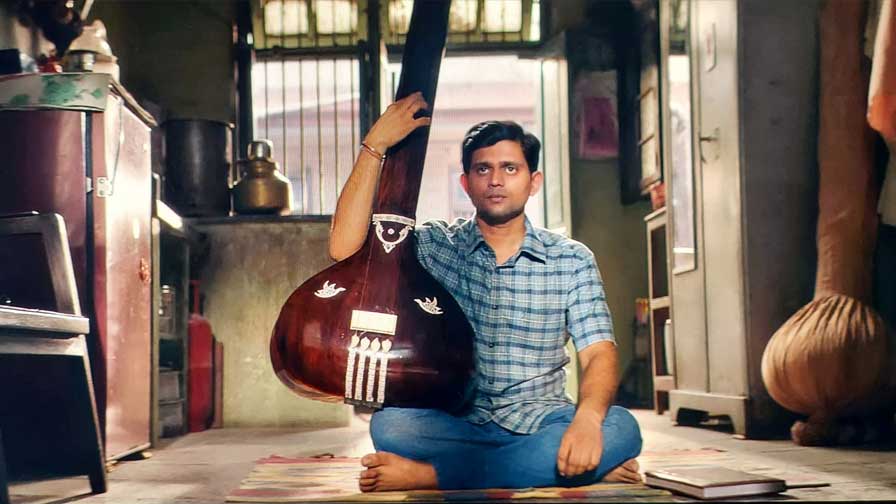

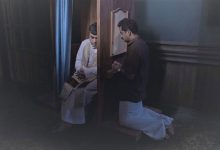

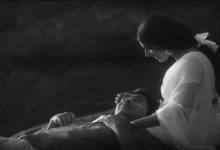
Leave a Reply
You must be logged in to post a comment.